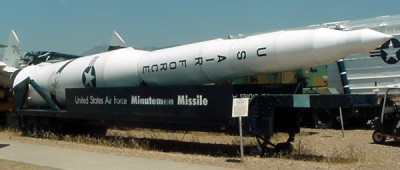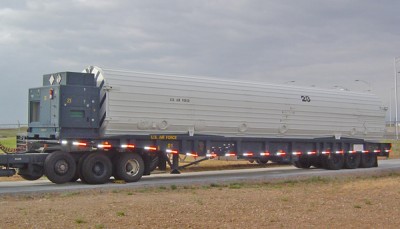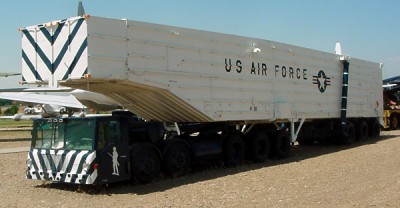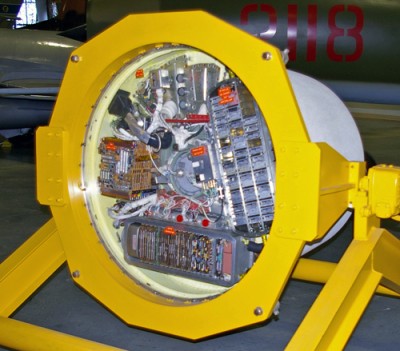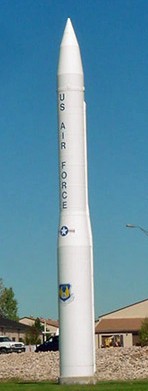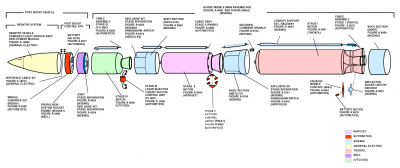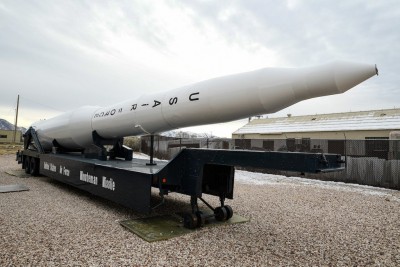Minuteman[/a title]
Minuteman is a three-stage intercontinental ballistic missile solid fuel, capable of carrying one or more (Minuteman II and III) nuclear warheads (W59, W62 or W78).
LGM in the designation of the missile means that the missile was designed to launch from an underground silo (L), to attack the ground targets (G) and it was a guided missile (M).
History[/heading]
During the implementation of the missile programs Atlas and Titan in the second half of the fifties of the twentieth century, the american air force began to realize that their first generation of strategic missiles, the liquid fuel has its disadvantages. Rocket fuel was dangerous in the performance, the rockets were expensive to maintain and launch, it took some time. Silos missiles Atlas and Titan had to be bigger, to fit a complex system for filling fuel into rockets - gaseous helium, liquid oxygen and a highly rafinové forms of kerosene RP-1. It took 15 minutes before the missile Atlas F filled almost 125 tons of this explosive mixture. And not always succeeded, 4 silos was destroyed by the blast while exercising with the performance of the fuel, a similar fate met the two silo missile Titan I.
The rockets on liquid fuel should your oduvodnění - for engines of the solid fuel, there were concerns of sufficient strength, the disadvantages put myself the impossibility of regulation and control already burned the engine. Air force but remained in favour of further development of these engines, and in the second half of the 50. years has the agency Western Development Division (WDD, responsible for the development of ICBM launchers) to the view that a new generation of rockets can be powered by engines solid fuel.
And so in 1957, designed by Edward Hall, a new family of rockets to solid fuel. The rockets should be both tactical, medium-range and intercontinental, they should be small, cheap, easy to maintain, kept in underground silos without the operator, capable of firing in a few - and produkovatelné in thousand-piece quantities. The air force first, his proposal neakceptovalo, because addressed in other projects, but eventually the missile, named the Minuteman, helped the rivalry between the air force and navy. You see, when the US Navy started interested in the project and zabudovalo him to your project missiles Polaris, the air force began to consider the involvement of rockets solid fuel into their plans. The agency WDD has yet to 1.7.1957 renamed the Air Force Ballistic Missile Division.
At the beginning of the year 1958 then he flew Hall to Washington to meet secretary of defense Neil H. McElroy, commander of the air force James H. Douglas, Jr., and commander of the Strategic air force (SAC) general Curtis Lemay with the draft Minuteman missiles. Compared with the Atlas rocket was the Minuteman small rocket with a weight of only 32 tons. Hall planned a three-stage rocket capable of carrying a nuclear warhead on the strength of 1-5 megatons at a distance of 1500-6500 miles. Missiles should be deployed on the territory of the united states in the silos without a human crew, only with a means of two-man command center for every 10 missile forces. Hall estimated that by the year 1965 can be deployed on the 1600 missiles Minuteman.
The air force and the ministry of defense was Hall the idea unešeno and within 24 hours of this presentation has ordered the air force agency AFBMD to begin limited work on the research and development of missiles Minuteman. Allocated her $ 50 million and has pledged an additional 100 million at the moment to show the viability of the proposed concept. In 1958 then, the agency started with the development of components and selecting vendors. In September 1959, convinced the agency AFBMD air force that the program Minuteman is ready for implementation and a month was selected, the company the Boeing Airplane Company of Seattle as a contractor responsible for final assembly of the rocket and testing. Boeing later produced the rocket in a huge factory postavene the army corps of engineers at Hill air force base in Utah.
Once he had completed the selection of suppliers, the program Minuteman continued at a very rapid pace. In February 1961 was carried out the first successful test flight from the base of the Air Force Missile Test Center at Florida, which included all three stages of the rocket and the guidance system. In November 1961, the then AFBMD has carried out successful missile launch complete Minuteman missiles from underground silos to Operational Standardization and Test Facility - Vanderbergově air force base in California. In march 1961 commenced construction of the first missile base for Minutemany to Malmstromovově air force base in Montana. It was completed in September 1962 and 22.10.1962 the SAC said the first unit of 10 missile Minuteman to operational readiness, just in time for the Cuban crisis. In June of 1963 was in the operational readiness of 150 missiles Minuteman, the number in October 1963 increased to 300 and 450 in march 1964. In June 1965 by the air force of 800. missile Minuteman on F.E. Warren air force base in Wyoming. The army corps of engineers under the help of prefabricated components and standardized construction techniques, built a grand underground missile silos.
In parallel with the construction of the fixed ground forces requested the SAC deployment of at least part of their missile forces in the mobile stations, to reduce the chances of being hit by any nuclear attack. 20.6.1960 so he started at Hill air force base Utah test under the name Operation Big Star. Trains loaded with missiles Minuteman are going up after the american railroad to explore all aspects of a mobile deployment - from the ability of the american railroads to ensure the operation of the "rocket" trains, despite the problems associated with command, control and communications, the influence of vibration on sensitive rocketry and launchers, to the human factor. 27.8.1960 is the last of the 4 test trains back to base and the air force could have the concept of declared successful. 1.12.1960 the air force activated the 4062nd Mobile Missile Wing - the wing should consist of three squadrons, each then should have 10 trains with 3 missiles. Program but did not find support in the Kennedy the government and at the end of the year 1961 was a mobile unit stricken from the budget - the wing was deactivated 20.2.1962.
Even before Minuteman missiles And manage to settle down in their underground silos, has already been launched a modernization program on the version of the Minuteman II and later Minuteman III. The last Minuteman I left the silo on Malstromově air force base in Montana 12.2.1969 and modernization ended 25.1.1975 the transmission of the last unit of Minuteman III on F.E.Warren air base in Wyoming.
Minuteman II[/heading]
2.10.1963, krártce after the introduction of the first squadrons of missiles Minuteman I, versions a And B, Headquarters air force decided to issue a Supplement, And to the Specific operational requirements 171, thus creating a demand for the development of Minuteman II (version F). This version should include a new, larger second stage of the rocket, better guidance systems, greater range and payload for a missile, also better ability to survive a nearby nuclear explosion. The secretary of defense Robert With. McNamara signed 8.11.1963 this modernization program, which marked the gradual replacement of all 150 missiles Minuteman I version And and 650 missiles Minuteman I B.
1.2.1965 headquarters SAC activated the 447th Strategic Missile Squadron at Air force base Grand Forks in the North Dakota as 17. a squadron equipped with missiles Minuteman and at the same time as the first equipped model of the Minuteman II. During the next 14 months were activated three more squadrons and the last, 20. squadron equipped with the missiles Minuteman (4. with missiles Minuteman II) was a unit of the 564th Strategic Missile Squadron on Malmstromovově air force base in Montana. As soon as the unit got into a state of operational readiness, 21.4.1967, aim to build up the strength of 1000 ICMB missiles Minuteman was filled with.
Upgrading the model of the Minuteman I started at 509th Strategic Missile Squadron on Whitemanově air force base in Missouri 7.5.1966, when it was replaced by the first ten missiles Minuteman I B.
Missile Minuteman II and remained in service during the entire Cold war. 27.9.1991 announced by the president George H.W. Bush in the tv transfer "plan for peace", reducing the tension of the atomic age. Within 72 hours should be withdrawn from operational readiness of all Minuteman missiles II (450 pieces) and in accordance with the treaty on the disarmament START should be these missiles and their silos and control centers destroyed.
Service in the control center[/heading]
Not unlike concrete submarine, hidden deep in the earth was the command center for the missile program Minuteman. The crew, which was in this space closed for a number of hours, experienced not only discomfort, but also a variety of stressful situations, knowing that if will sound an alarm tone and message from the SAC, it'll be they who they will open or confirm a nuclear armageddon.
During the first years of the program Minuteman work crew 36-48 hours in shifts of 8 or 12 hours in the control center, and breaks for rest in the break room. The soldiers in the aboveground part of the missile bases normally serve a three-day hike as a team, while two members of the "underground" crew usually served 36-48 hour shifts on average 5 times in a month. The length of the shifts was dependent on the distance of the rocket base from Ellswortovy air force base - some bases were remotely even 100 miles and crew had an even 2-to 3-hour trip to "civilization" (this path did not count in the service, as well as the time for the acceptance and transmission of the service !)
In July of 1977 was amended system of services on a 24-hour shift, which most of the soldiers kvitovala with gratitude. The original system entail major complications - the first 8 hours of shift, then 8 hours of rest, tv or sleep, then again 8 hours shift, and so over and over. After 48 hours "in the hole" was a man so messed up biological clocks, that didn't know, whether it is outside, day or night, and that it still expected a few hours behind the wheel.
The system change meant an increase in the number of shifts per month on the 8th.
The crew consisted of commander and deputy. The commander could become the only officer in the rank of First Lieutenant with at least a year and a half of practice on the position of the representative.
The main responsibility of the crew were of course monitoring the situation and constant readiness to launch the missiles. Among other responsibilities included coordination of maintenance, inspections of missiles and monitoring situation of rockets and support systems.
After the new crew arrived at the base, went through security control and authentication procedure. Then take the elevator down to the underground to the command center into the so-called "no-lone zone", freely translated "zone nesamostatnosti", because in this area he was not allowed to be one himself. On the basis of communication with the active crew have been opened osmitunové the protective door and the crew entered the control center.
Followed by handover of shift, a ten-minute briefing about the weather, call signs, secret daily military plan and the location of the individual keys. Every soldier předávál and took three items - a plastic card with the daily secret code for decoding orders from the SAC, the key to unlock the missile launch console, and revolver, caliber .38, which the soldiers had to defend in the unlikely case of an ambush (but the soldiers were not allowed this gun pull from the holster inside the control center).
Then, what for leaving the crew closed the airtight door, the new crew checked the records and support systems for missiles. Continued exercise and the passing of procedures to launch, getting ready for my inspection, SAC, etc.
If came the order to attack (Emergency War Order - EWO), both soldiers had to odemnout box containing the authentication codes. If matched with the incoming news, we both sat down on their seats, fasten your seat-belts and the master started the countdown. Deputy commander, switched a number of odjišťovacích switches, and missiles armed. Subsequently, they both insert their keys into the launch drivers - the drivers are so far apart that it couldn't control a single person. Followed by a conference call at the headquarters of the squadron, where the commander gave the order to launch missiles. According to the deduction of the commander of the garrison then came to turn the keys. In addition, Minuteman missiles can be fired without confirmation from another control center.
Rocket Minuteman was never detonated outside exercise, yet many of the soldiers probably get a good pounding heart, when in 1977 at the time of the transmission shift heard the information "wait for a message from the president of the united states". President Jimmy Carter then said : "Greetings to you all. I'm here in the control centre SAC and I just wanted to know how this all works". Usměvná story today back in 1977 could mean the end of the world.
If the firing actually occurred, the rocket would be fired from their underground silos in a cloud of smoke. 3 seconds after the start begins to slowly bow in the direction of your goal. The first stage of the rocket separated after 60 seconds at an altitude of 15 miles (24 km). The second stage is separated after 117 seconds, the third degree then after 181 seconds. At that time the rocket reaches a height of 118 miles (190km), and moves at the speed of 23000 feet per second (7km/s). In the apogee of its parabolic flight path reaches a height of 710 miles (1142km) above the earth's surface.
If there was no test flight, it was in this moment people in the target area just a few last moments ... And all mankind also.
Source :
https://en.wikipedia.org/wiki/LGM-30_Minuteman
www.techbastard.com
www.cr.nps.gov
.
During the implementation of the missile programs Atlas and Titan in the second half of the fifties of the twentieth century, the american air force began to realize that their first generation of strategic missiles, the liquid fuel has its disadvantages. Rocket fuel was dangerous in the performance, the rockets were expensive to maintain and launch, it took some time. Silos missiles Atlas and Titan had to be bigger, to fit a complex system for filling fuel into rockets - gaseous helium, liquid oxygen and a highly rafinové forms of kerosene RP-1. It took 15 minutes before the missile Atlas F filled almost 125 tons of this explosive mixture. And not always succeeded, 4 silos was destroyed by the blast while exercising with the performance of the fuel, a similar fate met the two silo missile Titan I.
The rockets on liquid fuel should your oduvodnění - for engines of the solid fuel, there were concerns of sufficient strength, the disadvantages put myself the impossibility of regulation and control already burned the engine. Air force but remained in favour of further development of these engines, and in the second half of the 50. years has the agency Western Development Division (WDD, responsible for the development of ICBM launchers) to the view that a new generation of rockets can be powered by engines solid fuel.
And so in 1957, designed by Edward Hall, a new family of rockets to solid fuel. The rockets should be both tactical, medium-range and intercontinental, they should be small, cheap, easy to maintain, kept in underground silos without the operator, capable of firing in a few - and produkovatelné in thousand-piece quantities. The air force first, his proposal neakceptovalo, because addressed in other projects, but eventually the missile, named the Minuteman, helped the rivalry between the air force and navy. You see, when the US Navy started interested in the project and zabudovalo him to your project missiles Polaris, the air force began to consider the involvement of rockets solid fuel into their plans. The agency WDD has yet to 1.7.1957 renamed the Air Force Ballistic Missile Division.
At the beginning of the year 1958 then he flew Hall to Washington to meet secretary of defense Neil H. McElroy, commander of the air force James H. Douglas, Jr., and commander of the Strategic air force (SAC) general Curtis Lemay with the draft Minuteman missiles. Compared with the Atlas rocket was the Minuteman small rocket with a weight of only 32 tons. Hall planned a three-stage rocket capable of carrying a nuclear warhead on the strength of 1-5 megatons at a distance of 1500-6500 miles. Missiles should be deployed on the territory of the united states in the silos without a human crew, only with a means of two-man command center for every 10 missile forces. Hall estimated that by the year 1965 can be deployed on the 1600 missiles Minuteman.
The air force and the ministry of defense was Hall the idea unešeno and within 24 hours of this presentation has ordered the air force agency AFBMD to begin limited work on the research and development of missiles Minuteman. Allocated her $ 50 million and has pledged an additional 100 million at the moment to show the viability of the proposed concept. In 1958 then, the agency started with the development of components and selecting vendors. In September 1959, convinced the agency AFBMD air force that the program Minuteman is ready for implementation and a month was selected, the company the Boeing Airplane Company of Seattle as a contractor responsible for final assembly of the rocket and testing. Boeing later produced the rocket in a huge factory postavene the army corps of engineers at Hill air force base in Utah.
Once he had completed the selection of suppliers, the program Minuteman continued at a very rapid pace. In February 1961 was carried out the first successful test flight from the base of the Air Force Missile Test Center at Florida, which included all three stages of the rocket and the guidance system. In November 1961, the then AFBMD has carried out successful missile launch complete Minuteman missiles from underground silos to Operational Standardization and Test Facility - Vanderbergově air force base in California. In march 1961 commenced construction of the first missile base for Minutemany to Malmstromovově air force base in Montana. It was completed in September 1962 and 22.10.1962 the SAC said the first unit of 10 missile Minuteman to operational readiness, just in time for the Cuban crisis. In June of 1963 was in the operational readiness of 150 missiles Minuteman, the number in October 1963 increased to 300 and 450 in march 1964. In June 1965 by the air force of 800. missile Minuteman on F.E. Warren air force base in Wyoming. The army corps of engineers under the help of prefabricated components and standardized construction techniques, built a grand underground missile silos.
In parallel with the construction of the fixed ground forces requested the SAC deployment of at least part of their missile forces in the mobile stations, to reduce the chances of being hit by any nuclear attack. 20.6.1960 so he started at Hill air force base Utah test under the name Operation Big Star. Trains loaded with missiles Minuteman are going up after the american railroad to explore all aspects of a mobile deployment - from the ability of the american railroads to ensure the operation of the "rocket" trains, despite the problems associated with command, control and communications, the influence of vibration on sensitive rocketry and launchers, to the human factor. 27.8.1960 is the last of the 4 test trains back to base and the air force could have the concept of declared successful. 1.12.1960 the air force activated the 4062nd Mobile Missile Wing - the wing should consist of three squadrons, each then should have 10 trains with 3 missiles. Program but did not find support in the Kennedy the government and at the end of the year 1961 was a mobile unit stricken from the budget - the wing was deactivated 20.2.1962.
Even before Minuteman missiles And manage to settle down in their underground silos, has already been launched a modernization program on the version of the Minuteman II and later Minuteman III. The last Minuteman I left the silo on Malstromově air force base in Montana 12.2.1969 and modernization ended 25.1.1975 the transmission of the last unit of Minuteman III on F.E.Warren air base in Wyoming.
Minuteman II[/heading]
2.10.1963, krártce after the introduction of the first squadrons of missiles Minuteman I, versions a And B, Headquarters air force decided to issue a Supplement, And to the Specific operational requirements 171, thus creating a demand for the development of Minuteman II (version F). This version should include a new, larger second stage of the rocket, better guidance systems, greater range and payload for a missile, also better ability to survive a nearby nuclear explosion. The secretary of defense Robert With. McNamara signed 8.11.1963 this modernization program, which marked the gradual replacement of all 150 missiles Minuteman I version And and 650 missiles Minuteman I B.
1.2.1965 headquarters SAC activated the 447th Strategic Missile Squadron at Air force base Grand Forks in the North Dakota as 17. a squadron equipped with missiles Minuteman and at the same time as the first equipped model of the Minuteman II. During the next 14 months were activated three more squadrons and the last, 20. squadron equipped with the missiles Minuteman (4. with missiles Minuteman II) was a unit of the 564th Strategic Missile Squadron on Malmstromovově air force base in Montana. As soon as the unit got into a state of operational readiness, 21.4.1967, aim to build up the strength of 1000 ICMB missiles Minuteman was filled with.
Upgrading the model of the Minuteman I started at 509th Strategic Missile Squadron on Whitemanově air force base in Missouri 7.5.1966, when it was replaced by the first ten missiles Minuteman I B.
Missile Minuteman II and remained in service during the entire Cold war. 27.9.1991 announced by the president George H.W. Bush in the tv transfer "plan for peace", reducing the tension of the atomic age. Within 72 hours should be withdrawn from operational readiness of all Minuteman missiles II (450 pieces) and in accordance with the treaty on the disarmament START should be these missiles and their silos and control centers destroyed.
Service in the control center[/heading]
Not unlike concrete submarine, hidden deep in the earth was the command center for the missile program Minuteman. The crew, which was in this space closed for a number of hours, experienced not only discomfort, but also a variety of stressful situations, knowing that if will sound an alarm tone and message from the SAC, it'll be they who they will open or confirm a nuclear armageddon.
During the first years of the program Minuteman work crew 36-48 hours in shifts of 8 or 12 hours in the control center, and breaks for rest in the break room. The soldiers in the aboveground part of the missile bases normally serve a three-day hike as a team, while two members of the "underground" crew usually served 36-48 hour shifts on average 5 times in a month. The length of the shifts was dependent on the distance of the rocket base from Ellswortovy air force base - some bases were remotely even 100 miles and crew had an even 2-to 3-hour trip to "civilization" (this path did not count in the service, as well as the time for the acceptance and transmission of the service !)
In July of 1977 was amended system of services on a 24-hour shift, which most of the soldiers kvitovala with gratitude. The original system entail major complications - the first 8 hours of shift, then 8 hours of rest, tv or sleep, then again 8 hours shift, and so over and over. After 48 hours "in the hole" was a man so messed up biological clocks, that didn't know, whether it is outside, day or night, and that it still expected a few hours behind the wheel.
The system change meant an increase in the number of shifts per month on the 8th.
The crew consisted of commander and deputy. The commander could become the only officer in the rank of First Lieutenant with at least a year and a half of practice on the position of the representative.
The main responsibility of the crew were of course monitoring the situation and constant readiness to launch the missiles. Among other responsibilities included coordination of maintenance, inspections of missiles and monitoring situation of rockets and support systems.
After the new crew arrived at the base, went through security control and authentication procedure. Then take the elevator down to the underground to the command center into the so-called "no-lone zone", freely translated "zone nesamostatnosti", because in this area he was not allowed to be one himself. On the basis of communication with the active crew have been opened osmitunové the protective door and the crew entered the control center.
Followed by handover of shift, a ten-minute briefing about the weather, call signs, secret daily military plan and the location of the individual keys. Every soldier předávál and took three items - a plastic card with the daily secret code for decoding orders from the SAC, the key to unlock the missile launch console, and revolver, caliber .38, which the soldiers had to defend in the unlikely case of an ambush (but the soldiers were not allowed this gun pull from the holster inside the control center).
Then, what for leaving the crew closed the airtight door, the new crew checked the records and support systems for missiles. Continued exercise and the passing of procedures to launch, getting ready for my inspection, SAC, etc.
If came the order to attack (Emergency War Order - EWO), both soldiers had to odemnout box containing the authentication codes. If matched with the incoming news, we both sat down on their seats, fasten your seat-belts and the master started the countdown. Deputy commander, switched a number of odjišťovacích switches, and missiles armed. Subsequently, they both insert their keys into the launch drivers - the drivers are so far apart that it couldn't control a single person. Followed by a conference call at the headquarters of the squadron, where the commander gave the order to launch missiles. According to the deduction of the commander of the garrison then came to turn the keys. In addition, Minuteman missiles can be fired without confirmation from another control center.
Rocket Minuteman was never detonated outside exercise, yet many of the soldiers probably get a good pounding heart, when in 1977 at the time of the transmission shift heard the information "wait for a message from the president of the united states". President Jimmy Carter then said : "Greetings to you all. I'm here in the control centre SAC and I just wanted to know how this all works". Usměvná story today back in 1977 could mean the end of the world.
If the firing actually occurred, the rocket would be fired from their underground silos in a cloud of smoke. 3 seconds after the start begins to slowly bow in the direction of your goal. The first stage of the rocket separated after 60 seconds at an altitude of 15 miles (24 km). The second stage is separated after 117 seconds, the third degree then after 181 seconds. At that time the rocket reaches a height of 118 miles (190km), and moves at the speed of 23000 feet per second (7km/s). In the apogee of its parabolic flight path reaches a height of 710 miles (1142km) above the earth's surface.
If there was no test flight, it was in this moment people in the target area just a few last moments ... And all mankind also.
Source :
https://en.wikipedia.org/wiki/LGM-30_Minuteman
www.techbastard.com
www.cr.nps.gov
.
Not unlike concrete submarine, hidden deep in the earth was the command center for the missile program Minuteman. The crew, which was in this space closed for a number of hours, experienced not only discomfort, but also a variety of stressful situations, knowing that if will sound an alarm tone and message from the SAC, it'll be they who they will open or confirm a nuclear armageddon.
During the first years of the program Minuteman work crew 36-48 hours in shifts of 8 or 12 hours in the control center, and breaks for rest in the break room. The soldiers in the aboveground part of the missile bases normally serve a three-day hike as a team, while two members of the "underground" crew usually served 36-48 hour shifts on average 5 times in a month. The length of the shifts was dependent on the distance of the rocket base from Ellswortovy air force base - some bases were remotely even 100 miles and crew had an even 2-to 3-hour trip to "civilization" (this path did not count in the service, as well as the time for the acceptance and transmission of the service !)
In July of 1977 was amended system of services on a 24-hour shift, which most of the soldiers kvitovala with gratitude. The original system entail major complications - the first 8 hours of shift, then 8 hours of rest, tv or sleep, then again 8 hours shift, and so over and over. After 48 hours "in the hole" was a man so messed up biological clocks, that didn't know, whether it is outside, day or night, and that it still expected a few hours behind the wheel.
The system change meant an increase in the number of shifts per month on the 8th.
The crew consisted of commander and deputy. The commander could become the only officer in the rank of First Lieutenant with at least a year and a half of practice on the position of the representative.
The main responsibility of the crew were of course monitoring the situation and constant readiness to launch the missiles. Among other responsibilities included coordination of maintenance, inspections of missiles and monitoring situation of rockets and support systems.
After the new crew arrived at the base, went through security control and authentication procedure. Then take the elevator down to the underground to the command center into the so-called "no-lone zone", freely translated "zone nesamostatnosti", because in this area he was not allowed to be one himself. On the basis of communication with the active crew have been opened osmitunové the protective door and the crew entered the control center.
Followed by handover of shift, a ten-minute briefing about the weather, call signs, secret daily military plan and the location of the individual keys. Every soldier předávál and took three items - a plastic card with the daily secret code for decoding orders from the SAC, the key to unlock the missile launch console, and revolver, caliber .38, which the soldiers had to defend in the unlikely case of an ambush (but the soldiers were not allowed this gun pull from the holster inside the control center).
Then, what for leaving the crew closed the airtight door, the new crew checked the records and support systems for missiles. Continued exercise and the passing of procedures to launch, getting ready for my inspection, SAC, etc.
If came the order to attack (Emergency War Order - EWO), both soldiers had to odemnout box containing the authentication codes. If matched with the incoming news, we both sat down on their seats, fasten your seat-belts and the master started the countdown. Deputy commander, switched a number of odjišťovacích switches, and missiles armed. Subsequently, they both insert their keys into the launch drivers - the drivers are so far apart that it couldn't control a single person. Followed by a conference call at the headquarters of the squadron, where the commander gave the order to launch missiles. According to the deduction of the commander of the garrison then came to turn the keys. In addition, Minuteman missiles can be fired without confirmation from another control center.
Rocket Minuteman was never detonated outside exercise, yet many of the soldiers probably get a good pounding heart, when in 1977 at the time of the transmission shift heard the information "wait for a message from the president of the united states". President Jimmy Carter then said : "Greetings to you all. I'm here in the control centre SAC and I just wanted to know how this all works". Usměvná story today back in 1977 could mean the end of the world.
If the firing actually occurred, the rocket would be fired from their underground silos in a cloud of smoke. 3 seconds after the start begins to slowly bow in the direction of your goal. The first stage of the rocket separated after 60 seconds at an altitude of 15 miles (24 km). The second stage is separated after 117 seconds, the third degree then after 181 seconds. At that time the rocket reaches a height of 118 miles (190km), and moves at the speed of 23000 feet per second (7km/s). In the apogee of its parabolic flight path reaches a height of 710 miles (1142km) above the earth's surface.
If there was no test flight, it was in this moment people in the target area just a few last moments ... And all mankind also.
